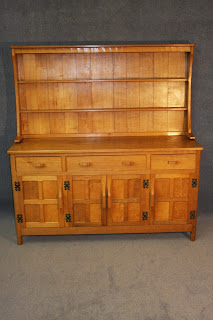ARTS AND CRAFTS FURNITURE
Alan Grainger Senior started working at Bradsby in North Yorkshire in 1934, after learning his craft at Medds in Easingwold. When Alan’s son, Alan Grainger Junior, joined the firm in 1958 Acorn Industries was formed and a year later they started using the 'acorn’ trademark. During the 1960s they were employing seven craftsmen with many other former apprentices setting up their own workshops in the area. The company closed in 2005 when Alan Grainger’s grandson Derek, the last family member of the business, retired.
On Wednesday 6th March we are offering these pieces from the Acorn workshop.
 |
| Lot 465 An "Acornman" Coffee table. 107cm long Estimate £50-£80 |
 |
| Lot 466 A set of "Acornman" oak dining chairs comprising 6 single and 2 carvers, all with ladder backs. Estimate £300-£500 |
 |
| Lot 468 An oak "Acornman" dresser with raised back, 3 drawers to the front, below 4 panelled doors, supported on octagonal legs. Estimate £300-£400 |
| Lot 467 An "Acornman" oak refectory table. 214cm long, 89cm wide Estimate £200-£300 |
This furniture is part of an Arts and Crafts movement known as the "Yorkshire Critters" made up of a band of apprentices and strong followers of Robert "Mouseman" Thompson. Robert Thompson of Kilburn, known as the 'Mouseman', worked in North Yorkshire. Thompson was born in 1876 and died 1955 and he started his business as a maker of ecclesiastical oak furnishings and furniture. It has been suggested that the ‘critters’ trademark came about by accident in 1919 after Robert Thompson had told one of his colleagues that he was 'as poor as a church mouse.’ At the time he was carving a cornice for a screen and this random remark inspired him to carve a small mouse which went on to become a trademark for all his works.
